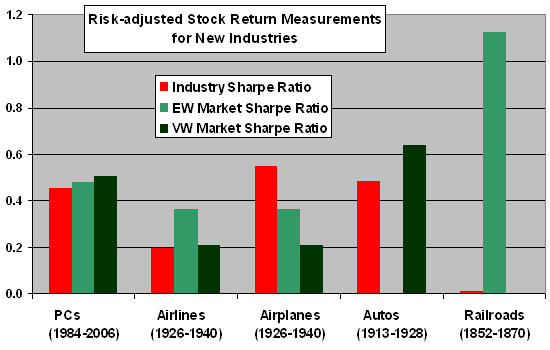Do new industries offer exceptionally good stock returns, whether through strong growth or investor exuberance? In their September 2008 paper entitled “Returns to Investors in Stocks in New Industries”, Gerald Dwyer Jr. and Cora Barnhart examine stock return distributions and summary statistics for the following major new industries in the U.S. over the periods of their initial development (15-23 years): personal computers, airlines, aircraft manufacturing, automobile manufacturing, railroads and telegraph. Using return data for the stocks of companies in the selected industries and contemporaneous market indexes, they conclude that:
- The stock returns of new industries are highly skewed. Similar to a lottery, a small number of companies generate outstanding returns, but many firms fail.
- The stocks of individual firms in new industries tend to be highly volatile. Consistent with notion that the market rewards risk-taking, the expected return for stocks in new industries is on average positive and substantial.
- However, equally weighted portfolios of firms in new industries generally have lower Sharpe ratios than does the broad U.S. stock market (see the chart below).
- With the exception of automobiles, there is an apparent pattern to the equally weighted stock returns of new industries over their first 15-20 years. Returns are first low (skepticism?), then well above average (exuberance?) and then low again (earnings reality?).
The following chart, constructed from data in the paper, compares Sharpe ratios for equally weighted new industry portfolios to those for contemporaneous equally weighted (EW) and value weighted (VW) market indexes, as available. The Sharpe ratios for industry portfolios are less than the Sharpe ratios for the overall market in the same period for all industries except airplane manufacturing. There is not sufficient stock return data from the era of telegraph industry emergence (1830s) to include that industry in the chart.

In summary, raw stock returns for firms in new U.S. industries tend on average to be positive and substantial, but very concentrated among a few companies. Risk-adjusted returns for new industries mostly match or underperform the broad U.S. stock market over their first 15-20 years.